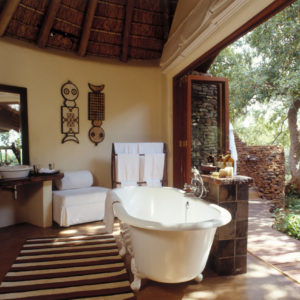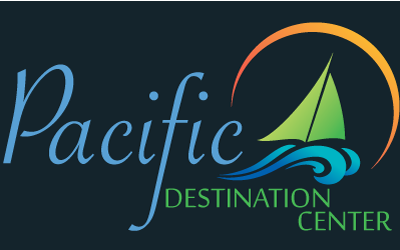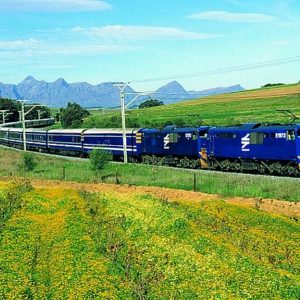Video courtesy of South Africa tourism
Southern Africa is a region of incredible diversity in landscape, wildlife and culture. Experience deserts, savannah, forests, coral reefs, endless beaches, mountains, modern cities, epic scenery and prolific wildlife. The people of South Africa are made up of many diverse cultures and hence it is known as the “Rainbow Nation” with eleven official languages.
There is nowhere better to view the “Big Five” than Southern Africa’s luxurious private reserves, where guests travel in open four-wheel-drive vehicles, allowing for unobstructed views of wildlife. Lion, leopard, buffalo, elephant and rhino can all be found and with highly skilled rangers who know just where to look. Bird life is prolific and for the sheer variety of flora, only the Amazon rivals the density of all species found here.
In the Cape region, Mediterranean in climate and European in culture, you will find ample opportunities for day cruises, nature hikes, wine tasting and simply soaking up the spectacular view.
Johannesburg’s Central Business District continues to evolve, with an ongoing urban renewal and cultural regeneration programme breathing new life into the city.
Must-do activities include the Apartheid Museum and Constitution Hill to find out more about South Africa’s turbulent past; sun-downers at Four Seasons Hotel Westcliff overlooking the green belt of Johannesburg while listening to the lions roar from the nearby Johannesburg Zoo; shopping up a storm at any of the many designer malls such as Sandton City, Nelson Mandela Square, Rosebank Mall and Soweto’s Maponya Mall; and, as a fitting end to all the fun, a visit to one of many health and beauty spas, or a walk in one of the many parks.
A mix of Malay, Dutch, French, Portuguese and African flavour is reflected in Cape Town’s stylish restaurant menus, where locally produced wines complement popular seafood and curry dishes.
Discover wines at source in the famous Cape Winelands by taking a day tour on one of six wine routes, and explore the historically rich adjacent towns of Stellenbosch, Franschhoek and Paarl.
If you’d prefer to tap into hops rather than grapes, a number of locally brewed craft beers are sold at pubs in and around the city.
An abundance of flora may be appreciated within the city environs, from the magnificence of the Kirstenbosch National Botanical Garden to a World Heritage Site featuring more than 9 000 fynbos (‘fine bush’) species in the Table Mountain National Park.
Cape Town’s beaches are a huge drawcard during the hot summer (November to February) months, while winter surf conditions are more favourable for all surf-related disciplines – including extreme wave riding at Dungeons, off Hout Bay.
The city’s leisure-loving lifestyle and mountainous backdrop have given rise to myriad leisure pursuits: hiking, mountain biking, paragliding, abseiling, helicopter flips and skydiving.
A top attractions itinerary for the Mother City ought to include a trip up the aerial cableway to the top of Table Mountain, a New7Wonder of Nature; a boat trip to Robben Island, where world-renowned humanitarian Nelson Mandela was incarcerated for 18 years; a tour of the Winelands in Durbanville or Stellenbosch; a sightseeing trip along Chapman’s Peak Drive; a relaxing afternoon at the V&A Waterfront; and a drive to Simon’s Town, where a breeding colony of African penguins lives on Boulders Beach.
Wine tasting, winemaking tours, excellent cuisine and magnificent scenery collectively create an irresistible attraction for international and local travellers alike.
South Africa’s winelands stretch from the Cape Overberg in the south-western Cape, through the Little Karoo and the West Coast into the adjacent province of the the Northern Cape. There are also wine farms in the Free State, KwaZulu-Natal and even Gauteng. The Cape Winelands are the most well-known, and include the Route 62 wine route, said to be the world’s longest wine route.
Most Cape wine estates are characterised by classic Cape Dutch-style buildings and massive vineyards with picturesque mountains as a backdrop. There is also a distinct European influence in number of regions, thanks to the arrival of French Huguenot, Dutch and German settlers during the 18th century.
Spier Wine Estate has one of the Cape’s the oldest wine cellars, dating back to 1767. The estate continues to produce world-class wines to this day.
The Stellenbosch Wine Route, South Africa’s oldest, was founded in 1971. JC Le Roux, a world-renowned sparkling wine, is produced here.
The town of Robertson, two hours’ drive east of Cape Town, is home to the acclaimed Robertson Winery, winner of numerous international awards for its Shiraz, sauvignon blanc and chardonnay varietals.
In addition to its wine, the Wellington region is famous for its brandy. The Schalk Burger & Sons Welbedacht Estate in this area is owned and run by former and current international rugby players, Schalk Burger snr and his son of the same name.
Paarl, the third-oldest town in South Africa, is home to the internationally renowned Nederburg Wine Estate, as well as numerous other premier brands.
Constantia, a 20 minutes’ drive from Cape Town, is the closest wine region to the Mother City.
The Franschhoek Wine Valley is also famous for its food and is acknowledged as the ‘gourmet capital of South Africa’.
The Garden Route is a mix of modern golf courses, ancient forests, secluded artists’ communities, retirement estates, modern malls, craft centres, mountain hideaways and beach holidays. A large number of interesting and creative people are drawn to this magnificent stretch of coastline and many of them now call it home.
The main highway through The Garden Route, a highlight on most visitors’ itineraries, is the N2 stretch running from Heidelberg in the Southern Cape to Storms River Village on the Eastern Cape border.
While the scenery is enough to make you stop and stare, it’s the hidden gems that can be found on the sides of the roads that are the real allure of the Garden Route.
Over time ancient woodcutter clans, fishermen, artists, businessmen and top chefs have all found their niches along the Garden Route in the Western Cape. The latest addition of which is the Bramon Wine Farm just outside Plettenberg Bay. This empowerment project is bringing wine-making, and all of its economic benefits, to the region. It doesn’t just do good, it tastes good too!
Oudtshoorn (the ostrich capital of the world) also calls the Garden Route home and, for those who are interested in history, both early inhabitants and elephants have been crossing the Outeniqua Mountains, from Oudtshoorn to the coast, for many centuries.
Other surrounding towns well worth visiting include Calitzdorp, Sedgefield, The Wilderness, Knysna and Plettenberg Bay.
The Garden Route National Park which connects the existing Tsitsikamma National Park’s ancient forests and wild coastline with the Wilderness National Park via a chain of lakes and preserved sections of Fynbos, is a fascinating and enchanting mix of ecosystems. This park is also famous for its secluded little bays and its year-round holiday frame-of-mind, and it’s conveniently accessible from Cape Town.
While you’re exploring all the nooks and crannies of the Garden Route, don’t forget to cast an eye out to sea where you could see the Southern Right and Humpback Whales, Bottlenose and common dolphins and even Killer Whales that have been known to frolic close to the shore, especially near Plettenberg Bay.
Whatever your pleasure is, you’ll find what you’re looking on the Garden Route… even if it’s just to lose yourself in one of the most beautiful parts of South Africa, if not the world.
When you think of South Africa and iconic the Kruger National Park most certainly comes to mind. Not only can you catch a glimpse of the famous Big Five here but you will find yourself surrounded by hundreds of species of birds, ancient trees, winding rivers and so much more. Basically, it’s your one-stop shop for all of your wildlife dreams.
Imagine rising with the South African sun. Driving out of your camp, filled with anticpation as you keep your eyes peeled for an overnight lion kill, a leopard casually draped over the branch of a big tree or a herd of elephants taking a morning stroll. Then ask yourself, is there anywhere else in the world you’d rather be?
The Kruger National Park is home to thousands of animals. From giraffes browsing for Acacia leaves to chew on and a herd of buffalo crossing the road right in front of you, to elusive big cats enjoying a spot of shade and fish eagles letting out their distinctive call – it’s the Lion King in live action.
It’s hard to believe your eyes when you see the herds of hundreds of antelope or crocodiles basking in the afternoon sun while the hippos keep cool under water. Not to mention the things you’ll hear, they are just as unbelievable – hyenas cackling the night away as male lions roar for dominance, and if you’re lucky, the almost silent footsteps of a pack of wild dogs on the prowl.
This is just a small taste of all the things you can see, hear and do in one of the world’s most-loved game parks.
The Kruger National Park enjoys a great year-round sunny climate and offers all kinds of activities, from guided game drives and bush walks with an armed ranger to three-night walking trails in deep wilderness areas.
The warm Indian Ocean to the east and the Drakensberg Mountains to the west border KwaZulu-Natal, South Africa’s self-styled playground province, home to two World Heritage Sites: the iSimangaliso Wetland Park and the uKhahlamba-Drakensberg Park.
The imposing mountain range of the uKhahlamba-Drakensberg Park is celebrated for its San rock art as well as its beauty. More than 30 000 symbolic paintings adorn the walls and overhangs of 500 caves scattered throughout this extensive and ancient rocky landscape.
In and around the town of Ladysmith in the northern hinterland lies the historical Battlefields region, which has witnessed much spilling of blood. Zulu warriors, Boer garrisons and British troops clashed in many skirmishes in the region during the late 1800s. The most famous of these was the 118-day siege of Ladysmith during the South African (Anglo-Boer) War.
Culturally speaking, KwaZulu-Natal is a mix of Zulu, Indian and colonial influences, with each heritage reflected in historical and cultural trails, architecture, township cuisine and Durban’s fine Indian curries.
Game and nature reserves, unspoilt beaches and the iSimangaliso Wetland Park dominate the Elephant Coast north of the port city of Durban, while the Sapphire and Hibiscus coasts to the south comprise small holiday towns, holiday accommodation and numerous Blue Flag beaches.
About two hours’ drive inland from Durban, Nottingham Road marks the heart of the Midlands Meander, a country setting for more than 100 art and craft outlets, B&B and hotel accommodation, adventure sports destinations, pubs, farm-style and upmarket eateries, hiking and horse trails, and quaint getaway spots.
A sun-worship’s dream by day and a party destination by night, the beach-fronts of Durban and Umhlanga come alive, with clubs, pubs, live music, lounges and restaurants vying for patronage. Greater Durban’s Florida Road and Helen Joseph Road are popular meeting places for the young and trendy, where a strip of bistros and restaurants offer international and local cuisine.
Principal sights include the Okavango Delta, the Moremi game reserve in the centre of the delta, known for its predators and big five game viewing. The Chobe National Park and river draws huge numbers of game, while the area is also home to the highest concentration of elephants in Africa. The Kalahari is an endless expanse of land that occupies the centre of Botswana where the San people live.
Zambia has some of the greatest natural scenery on the continent – a gently undulating plateau of forests, savannah and marshland – studded with lakes. Zambia also boasts world-class wildlife parks such as the Mosi-Oa-Tunya National Park, Lower Zambezi National Park and the South Luangwa National Park. A visit to Zambia will make you will feel like you’ve been to the true heart of Africa.
Victoria Falls, the ‘tourist’ capital of Zimbabwe or Livingstone in Zambia, affectionately named ‘Vic Falls’ by anyone who has ever been there it is one of the world’s greatest natural wonders.
Summer is high season from October to April when it can get busy, and winter is from May to August the dry season. Summers tend to be quite hot, with daytime temperatures hovering around 30ºC (86ºF). For beach holidays and bird watching, summer tends to be the preferred time to visit.
Winter temperatures during the day are around 15ºC (59ºF) and nighttime temperatures can fall to as low as 0º (32ºF). Snowfalls are rare but occasionally occur on the higher mountains.
Showing all 2 results
-
 Africa & Morocco, East Africa, Southern Africa
Africa & Morocco, East Africa, Southern AfricaLuxury Lodges, Safari Camps & Boutique Hotels
Read moreNeed Assistance?
800-227-5317 | sales@pacific-destinations.com
Tell us where and when you want to go and we’ll give your request our immediate attention! No high pressure sales, just straight talk and sound advice!

